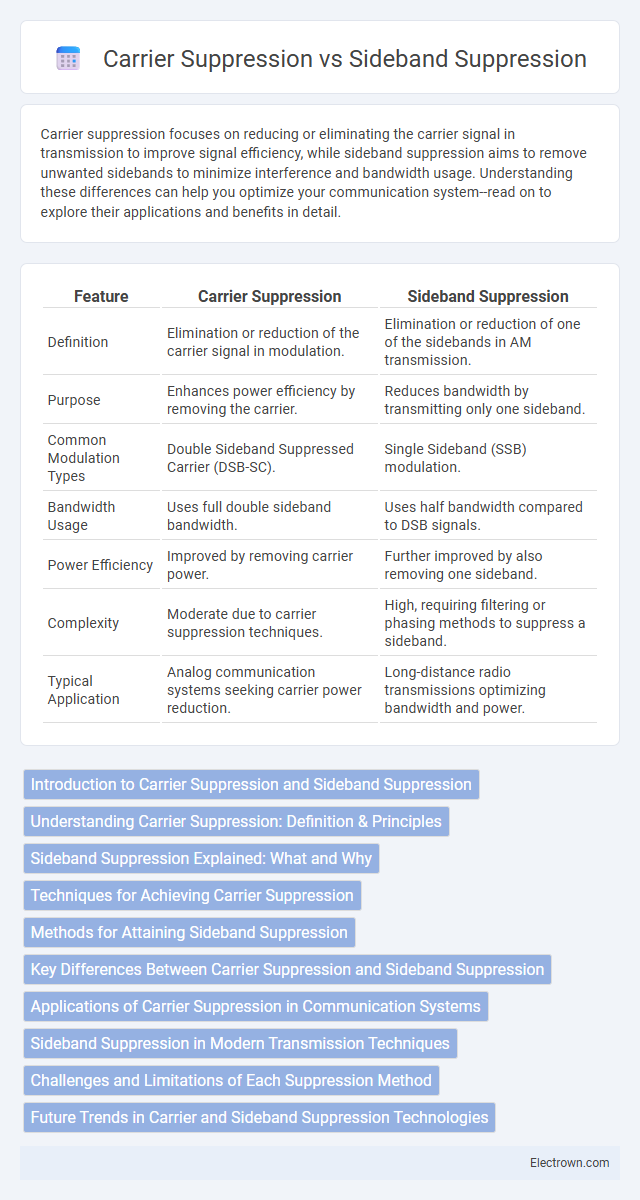Carrier suppression focuses on reducing or eliminating the carrier signal in transmission to improve signal efficiency, while sideband suppression aims to remove unwanted sidebands to minimize interference and bandwidth usage. Understanding these differences can help you optimize your communication system--read on to explore their applications and benefits in detail.
Table of Comparison
| Feature | Carrier Suppression | Sideband Suppression |
|---|---|---|
| Definition | Elimination or reduction of the carrier signal in modulation. | Elimination or reduction of one of the sidebands in AM transmission. |
| Purpose | Enhances power efficiency by removing the carrier. | Reduces bandwidth by transmitting only one sideband. |
| Common Modulation Types | Double Sideband Suppressed Carrier (DSB-SC). | Single Sideband (SSB) modulation. |
| Bandwidth Usage | Uses full double sideband bandwidth. | Uses half bandwidth compared to DSB signals. |
| Power Efficiency | Improved by removing carrier power. | Further improved by also removing one sideband. |
| Complexity | Moderate due to carrier suppression techniques. | High, requiring filtering or phasing methods to suppress a sideband. |
| Typical Application | Analog communication systems seeking carrier power reduction. | Long-distance radio transmissions optimizing bandwidth and power. |
Introduction to Carrier Suppression and Sideband Suppression
Carrier suppression involves reducing or eliminating the carrier frequency component in a modulated signal, improving power efficiency and minimizing interference in communication systems. Sideband suppression targets the reduction or removal of one or both sidebands in amplitude modulation to conserve bandwidth and reduce signal distortion. Both techniques are essential in optimizing signal transmission by managing spectral components for clearer and more efficient communication.
Understanding Carrier Suppression: Definition & Principles
Carrier suppression involves reducing or eliminating the carrier signal in modulation schemes to improve power efficiency and signal clarity by emphasizing sidebands that carry the information. This technique is fundamental in suppressed-carrier modulation formats like double sideband suppressed carrier (DSB-SC) and single sideband (SSB), where the carrier is minimized to conserve energy and reduce interference. Understanding carrier suppression helps optimize your communication system's performance by focusing transmission power on the informational sidebands rather than the redundant carrier frequency.
Sideband Suppression Explained: What and Why
Sideband suppression refers to the intentional reduction or elimination of one sideband in a signal, commonly used in single sideband (SSB) modulation to improve bandwidth efficiency and reduce interference. Carrier suppression, on the other hand, minimizes the carrier amplitude to conserve power and avoid unnecessary transmission, but does not eliminate sidebands. Understanding sideband suppression helps you optimize communication systems by enhancing signal clarity and conserving spectrum resources.
Techniques for Achieving Carrier Suppression
Techniques for achieving carrier suppression include balanced modulators and push-pull circuits, which effectively cancel out the carrier frequency by generating two signals that are equal in amplitude but opposite in phase. Using a diode ring modulator or double-balanced mixer enhances suppression by isolating the carrier from the output signal, improving sideband transmission clarity. Your choice of method impacts the level of carrier suppression and overall signal quality in applications such as single sideband (SSB) communication.
Methods for Attaining Sideband Suppression
Sideband suppression techniques primarily involve the use of balanced modulators and filters to minimize the unwanted sideband while preserving the desired signal component. Single-sideband (SSB) generation methods such as the Weaver method employ phasing and filtering to achieve high sideband suppression by eliminating the carrier and one sideband. Digital signal processing (DSP) algorithms also facilitate precise sideband suppression by dynamically adjusting phase and amplitude to enhance spectral efficiency in modern communication systems.
Key Differences Between Carrier Suppression and Sideband Suppression
Carrier suppression involves reducing the amplitude of the carrier signal in a modulation scheme to enhance signal efficiency, commonly used in techniques like double-sideband suppressed-carrier (DSB-SC) transmission. Sideband suppression targets the elimination or reduction of one of the sidebands in amplitude modulation to conserve bandwidth, exemplified in single-sideband (SSB) modulation. The key difference lies in carrier suppression focusing on minimizing carrier power for energy efficiency, while sideband suppression aims to eliminate redundant spectral components to reduce bandwidth usage.
Applications of Carrier Suppression in Communication Systems
Carrier suppression is crucial in single-sideband (SSB) modulation and quadrature amplitude modulation (QAM) systems, improving power efficiency by minimizing carrier power and emphasizing sidebands that carry information. It is widely applied in high-frequency (HF) and very high-frequency (VHF) transceivers, enabling long-distance voice and data communication with reduced bandwidth and interference. Carrier suppression enhances the performance of radio transmitters by reducing spectral waste, enabling clearer signals and improved signal-to-noise ratios in modern digital communication networks.
Sideband Suppression in Modern Transmission Techniques
Sideband suppression in modern transmission techniques enhances signal clarity by reducing interference and maximizing spectral efficiency. Techniques like Single Sideband (SSB) modulation suppress one sideband, allowing more power to be concentrated in the carrier or the remaining sideband, improving communication range and quality. Your transmission system benefits from sideband suppression by achieving clearer signals with less bandwidth consumption compared to traditional full-carrier methods.
Challenges and Limitations of Each Suppression Method
Carrier suppression faces challenges such as precise amplitude and phase control required to avoid residual carrier leakage, which can degrade signal quality and increase error rates. Sideband suppression struggles with frequency instability and filter imperfections, leading to incomplete suppression and potential crosstalk in adjacent channels. Your choice between these methods must consider these limitations to optimize system performance in communication applications.
Future Trends in Carrier and Sideband Suppression Technologies
Emerging trends in carrier and sideband suppression technologies emphasize advanced digital signal processing techniques and machine learning algorithms to enhance filter precision and adaptability. Integration of silicon photonics and MEMS-based tunable filters promises ultra-compact, low-power solutions for dynamic suppression in 5G and beyond communication systems. Future developments focus on real-time adaptive suppression mechanisms to improve spectral efficiency and reduce interference in increasingly congested wireless environments.
Carrier Suppression vs Sideband Suppression Infographic

 electrown.com
electrown.com